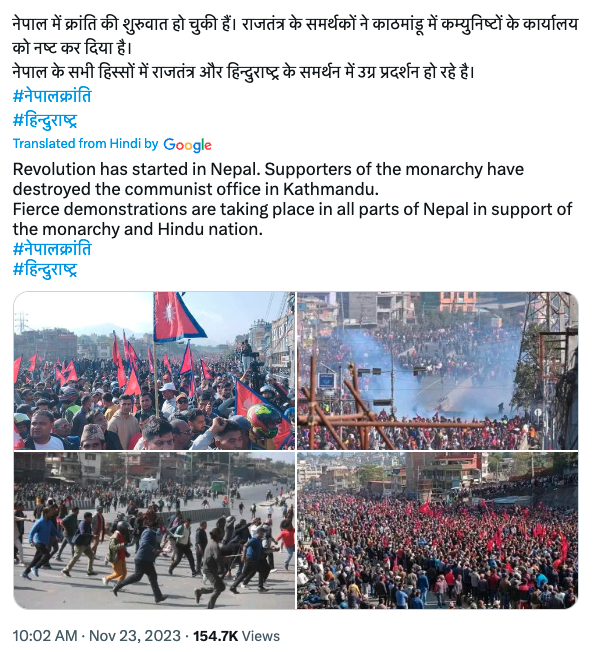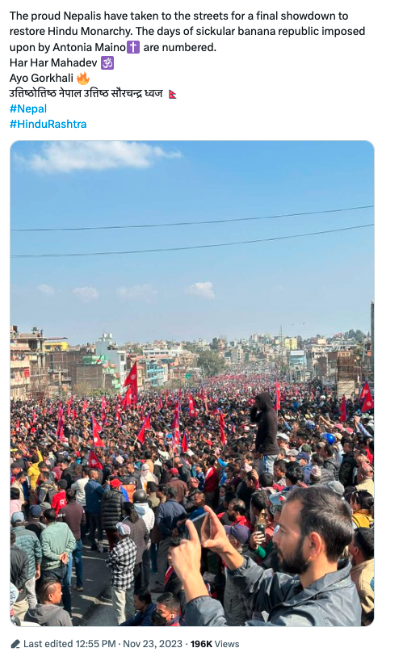Introduction
India’s influence on the rise of Hindu nationalism in Nepal has steadily grown under the leadership of Narendra Modi’s Bharatiya Janata Party (BJP). Religious tensions have been escalating in Nepal, where a growing Hindu nationalist movement is utilising social media to bolster support and rally followers. Following in the footsteps of BJP propagandists, Nepali social media influencers have popularised Hindu nationalism, or Hindutva, online. Political outfits taking after Modi’s BJP have gradually been gaining followers in Nepal, creating friction between pro-Hindu and non-Hindu Nepalis, resulting in outbreaks of violence and a bubbling extremist movement. This Insight will outline how social media is used to perpetuate Hindu nationalist sentiments and the role of online pro-Hindu rhetoric in facilitating real-world violence in Nepal.
Hindu Nationalism and the BJP in Nepal
Since the country officially became secular in 2008, many conservative Nepalis have sought to make Nepal a Hindu state with a renewed constitutional monarchy. India has caught onto this sentiment, with Modi deepening ties with Kathmandu via bilateral agreements strengthening the economic and transportation sectors. The BJP’s rule over India, headed by Modi, has cultivated a Hindu nationalist culture that has spread to the United States, Canada, the United Kingdom, and now Nepal. In a continued rivalry with China to become the continent’s dominant power, Modi has infused India’s politics with censorship, anti-Muslim discrimination and hate speech. His desire to advance his nationalist agenda comes at the perfect time, as Hindu extremism in Nepal is on the verge of eruption. Nepali Hindus, who comprise more than 80% of the country’s population, are likely to view Modi’s hand in their government as a chance to actualise Hindu underpinnings that have been quietly growing since Nepal’s turn to secularism in 2008.
The BJP’s growing influence on Nepali politics became apparent in a May 2023 US State Department International Religious Freedom Report, which claimed that Nepali civil society activists were accusing their government of receiving funding from BJP-linked Hindu nationalist cells in return for advancing a political agenda promoting Hindu statehood. The infiltration of the BJP into Nepal is a relatively new and emerging phenomenon that has gained the support of the Rastriya Prajatantra Party (RPP), a right-wing Nepali political group aiming to solidify Nepal’s Hindu statehood. The RPP has been steadily garnering support, winning almost 6% of votes in 2022, up from just over 2% in 2017. The influence of the RPP died down after Nepal became secular, but support for the group is on the rise again, with political rallies and events growing in both size and frequency. A more direct offshoot of the BJP is the Nepal Janata Party (NJP), a political faction whose influence has also been growing in Nepal’s politics. The NJP models itself after the BJP, utilising the same saffron colour scheme and the lotus flower symbol, which are traditional in Hindu nationalist imagery. Aiming for control over elections in 2027, NJP’s senior vice president, Khem Nath Acharya, declared full support for BJP ideology and a shared ultimate goal of establishing Nepal as exclusively Hindu. The party won 17 seats in local elections last year.
Nepali Hindu Nationalists Online
Anti-Muslim conspiracy theories have previously played a large role in Hindutva propaganda. In 2020, India’s right-wing news channels generated exaggerated reports that Muslim men infected with COVID-19 were sent from Pakistan to India by way of Nepal – claims that became known as ‘Corona-jihad’. This narrative originated in the Indian state of Bihar and claimed that a Muslim Nepali politician was behind the ‘corona-jihad’ stratagem. Consequently, the Nepal-India border was cordoned off. Islamophobic disinformation generated in India seems to have catalysed the pro-Hindu movement in Nepal, where social media users have taken a similar anti-Muslim stance. In April 2020, in Janakpur, Nepal, several Muslim women were accused of spitting on rupee bills, infecting them with COVID-19 and then leaving them on the ground for others to become infected. As a result, Islamophobic posts targeting Muslim Nepali women went viral.
RPP and NJP nationalists utilise social media platforms like Facebook, X (formerly Twitter) and TikTok to convey Hindu nationalist sentiments and spread awareness of the growing movement. On 23 November, a pro-monarchy ‘Hindu rashtra’ rally took place in Kathmandu. Tens of thousands of protestors descended on the capital and clashed with police. Nationalist social media influencers posted images and footage of the rally with over 150,000 views, claiming “Revolution has started in Nepal” (Fig. 1).

Fig. 1: Tweet with images of a Hindu nationalist rally in Nepal
On Facebook, dozens of pro-RPP groups have acquired thousands of followers, regularly posting political updates and speeches adorned with the flag and colours of the RPP. Another user on X with nearly 14k followers posted images of the same rally captioned “The proud Nepalis have taken to the streets for a final showdown to restore Hindu monarchy” with the hashtag “#HinduRashtra” – a call for Hindutva (Fig. 2). In August, videos of a large Hindu Rashtra rally in Dharan were posted on TikTok, amassing 158k views and many comments proclaiming “Jay Shree Ram”, a common public projection of Hindu faith. Nepal’s Hindu nationalist movement reflects a larger trend of calls for political and religious revolution in the country. Pro-Hindu sentiments expressed online have sparked outbreaks of violence and threaten Nepal’s non-Hindu population. Social media has emerged as a critical tool of political mobilisation in Nepal, just as it did in India, where the BJP has been accused of hate speech, anti-Muslim rhetoric and majoritarian authoritarianism.

Fig. 2: Image posted to Twitter/X showing a Hindu Rashtra rally in Nepal
Real-world Violence
Significantly, the Nepali Hindutva movement has not remained in cyberspace; pro-Hindu sentiments expressed online have spilt into real violence. After a young Nepali Hindu posted vulgar comments towards a Muslim on social media in October 2023, a group of Muslims blocked traffic, burned tyres and protested inside their local government office in the city of Nepalgunj. Days later, a mass of Hindus paraded the streets, provoking Muslim protesters and throwing projectiles. This incident came just days after a Hindu religious leader named Acharya Shriniwas was arrested for inciting religious division during a speech in Dhanusha. Shriniwas later made controversial and inciteful comments about the conflict in Nepalgunj on social media. Nepali security agencies have allegedly linked Shriniwas with extremist groups, raising questions about his connections to the BJP.
The sharp uptick of Hindu nationalist sentiment in Nepal has sparked furore towards Christians and other religious minorities in the country, too. The aforementioned US State Department report claims that various Christian groups and non-governmental organisations (NGOs) in Nepal are experiencing difficulty operating safely. Christian leaders have verbalised frustration with anti-Christian sentiments expressed by the RPP and claim they have faced challenges reinstating their groups as official entities with the government. Refugees from Tibet have also purportedly faced targeting with excessive criminal laws, such as restrictions on where Tibetan Buddhists can celebrate holidays and how big their congregations can be. As a result, religious freedom in Nepal is becoming increasingly under threat, with bans on proselytisation still in effect from 1990. Hence, the escalating Nepali Hindutva movement strongly reflects the religious persecution faced by many in Nepal.
The Future of Hindu Nationalism in South Asia
The direct role of the BJP in influencing Nepali politics is still blurry, but the party has made itself visible in Nepal through public speeches, financial incentivisation and pressure tactics. What is certain is that the establishment of Nepal as an exclusively Hindu state will directly benefit India in an already contentious competition for regional control of South Asia’s smaller but geographically significant countries, including Nepal, Sri Lanka and the Maldives. Modi’s recent visits to Nepal are rooted in such efforts and reflect his growing intention to establish a foothold in the country.
Nepal is just another piece of the puzzle for India; the more Modi can extend his hand from domestic to international politics, the greater chance he will have at achieving his goals. Social media is a critical tool for Hindu nationalists, swaying Indian and Nepali citizens’ political outlooks from keen-eyed voters to hardline nationalists. The aim of the RPP and NJP to incite Hindu nationalism transnationally in South Asia demands a measured response from international fora to prevent escalation and further outbreaks of violence. Tech companies like Facebook and X might consider the nuances of minority languages and religions in directing the safe use of their platforms. The complexities of the region’s diverse socio-religious identities demand that social media platforms think critically about taking an effective but fair stance in modulating particular content rooted in religious or political frameworks. It is imperative that these platforms exert their full efforts to combat disinformation, hate speech and extremist content for the safety of all users. We are witnessing the growth of Hindu nationalism in power and breadth in South Asia, with social media remaining a key facet of mobilising support for the cause.
Joshua Bowes is a Research Associate with futures think tank South Asia Foresight Network (SAFN) in Washington, D.C, focusing on South Asian security challenges. His research primarily covers synergetic thinking, militancy, armed conflict and extremism.
